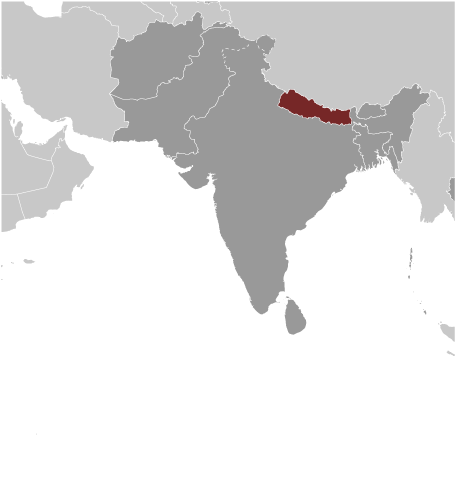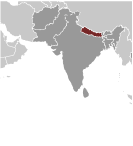
|
|
Advertisements:
EconomyEconomy - overview
Nepal is among the poorest and least developed countries in the world, with almost one-quarter of its population living below the poverty line. Agriculture is the mainstay of the economy, providing a livelihood for three-fourths of the population and accounting for about one-third of GDP. Industrial activity mainly involves the processing of agricultural products, including pulses, jute, sugarcane, tobacco, and grain. Nepal has considerable scope for exploiting its potential in hydropower, with an estimated 42,000 MW of feasible capacity, but political instability hampers foreign investment. Additional challenges to Nepal's growth include its landlocked geographic location, civil strife and labor unrest, and its susceptibility to natural disaster. Gdp (purchasing power parity) World Ranking: 100
$38.28 billion (2011 est.)
$36.99 billion (2010 est.) $35.38 billion (2009 est.) Note Data are in 2011 US dollars Gdp (official exchange rate)
$18.58 billion (2011 est.)
Gdp - real growth rate World Ranking: 109
3.5% (2011 est.)
4.6% (2010 est.) 4.4% (2009 est.) Gdp - per capita (ppp) World Ranking: 204
$1,300 (2011 est.)
$1,300 (2010 est.) $1,300 (2009 est.) Note Data are in 2011 US dollars Gdp - composition by sector
Agriculture 34.9%
Industry 15% Services 50.1% (2010 est.) Labor force World Ranking: 33
18 million
Note Severe lack of skilled labor (2009 est.) Labor force - by occupation
Agriculture 75%
Industry 7% Services 18% (2010 est.) Unemployment rate World Ranking: 191
46% (2008 est.)
42% (2004 est.) Population below poverty line
25.2% (2011 est.)
Household income or consumption by percentage share
Lowest 10% 3.2%
Highest 10% 29.5% (2011) Distribution of family income - gini index World Ranking: 31
47.2 (2008)
36.7 (1996) Budget
Revenues $3.9 billion
Expenditures $5.3 billion (FY11) Taxes and other revenues World Ranking: 153
21% of GDP (FY11)
Budget surplus (+) or deficit (-) World Ranking: 185
-7.5% of GDP (FY11)
Inflation rate (consumer prices) World Ranking: 187
9.1% (2011 est.)
10% (2010 est.) Central bank discount rate World Ranking: 58
6% (31 December 2010 est.)
6.5% (31 December 2009 est.) Commercial bank prime lending rate World Ranking: 117
7.5% (31 December 2011 est.)
8% (31 December 2010 est.) Stock of narrow money World Ranking: 119
$2.696 billion (31 December 2011 est.) $2.93 billion (31 December 2010 est.) Stock of broad money World Ranking: 98
$12.12 billion (31 December 2011 est.) $10.34 billion (31 December 2010 est.) Stock of domestic credit World Ranking: 94
$11.42 billion (31 December 2011 est.) $11.17 billion (31 December 2010 est.) Market value of publicly traded shares World Ranking: 82
$4.529 billion (31 December 2011 est.) $4.843 billion (31 December 2010) $5.485 billion (31 December 2009 est.) Agriculture - products
Pulses, rice, corn, wheat, sugarcane, jute, root crops; milk, water buffalo meat Industries
Tourism, carpets, textiles; small rice, jute, sugar, and oilseed mills; cigarettes, cement and brick production Industrial production growth rate World Ranking: 133
1.4% (FY10)
Electricity - production World Ranking: 125
3.156 billion kWh (2010 est.)
Electricity - consumption World Ranking: 115
4.833 billion kWh (2010 est.)
Electricity - exports
0 kWh (2010 est.)
Electricity - imports
70 million kWh (2010 est.)
Oil - production World Ranking: 207
0 bbl/day (2010 est.)
Oil - consumption World Ranking: 127
20,000 bbl/day (2010 est.)
Oil - exports World Ranking: 184
0 bbl/day (2010 est.)
Oil - imports World Ranking: 134
13,740 bbl/day (2009 est.)
Oil - proved reserves World Ranking: 171
0 bbl (1 January 2011 est.)
Natural gas - production World Ranking: 105
0 cu m (2010 est.)
Natural gas - consumption World Ranking: 113
0 cu m (2009 est.)
Natural gas - exports World Ranking: 151
0 cu m (2010 est.)
Natural gas - imports World Ranking: 100
0 cu m (2010 est.)
Natural gas - proved reserves World Ranking: 108
0 cu m (1 January 2011 est.)
Current account balance World Ranking: 103
-$437.8 million (2010 est.)
$537 million (2009 est.) Exports World Ranking: 161
$896 million (2011 est.)
$901.8 million (2010 est.) Exports - commodities
Clothing, pulses, carpets, textiles, juice, pashima, jute goods Exports - partners
India 59.2%, US 9.2%, Germany 5.2% (2011) Imports World Ranking: 123
$5.4 billion (2011 est.)
$5.017 billion (2010 est.) Imports - commodities
Petroleum products, machinery and equipment, gold, electrical goods, medicine Imports - partners
India 54.4%, China 27.5% (2011) Reserves of foreign exchange and gold
$2.925 billion Debt - external World Ranking: 128
$3.777 billion (31 December 2011 est.) $3.673 billion (31 December 2010 est.) Stock of direct foreign investment - at home
$NA
Stock of direct foreign investment - abroad
$NA
Exchange rates
Nepalese rupees (NPR) per US dollar - 74.02 (2011 est.)73.16 (2010 est.) 77.44 (2009) 65.21 (2008) 70.35 (2007) Fiscal year
16 July - 15 July
Comments
Add a new comment: |
Advertisement
Members area
Nepal (Kathmandu):
 
GPS points from Nepal (Kathmandu)
|
||||||||

 In 1951, the Nepali monarch ended the century-old system of rule by hereditary premiers and instituted a cabinet system of government. Reforms in 1990 established a multiparty democracy within the framework of a constitutional monarchy. An insurgency led by Maoist extremists broke out in 1996. The ensuing 10-year civil war between insurgents and government forces witnessed the dissolution of the cabinet and parliament and assumption of absolute power by the king. Several weeks of mass protests in April 2006 were followed by several months of peace negotiations between the Maoists and government officials, and culminated in a November 2006 peace accord and the promulgation of an interim constitution. Following a nation-wide election in April 2008, the newly formed Constituent Assembly declared Nepal a federal democratic republic and abolished the monarchy at its first meeting the following month. The Constituent Assembly elected the country's first president in July. Between 2008 and 2011 there have been four different coalition governments, led twice by the United Communist Party of Nepal-Maoist, which received a plurality of votes in the Constituent Assembly election, and twice by the Communist Party of Nepal-United Marxist-Leninist. In November 2011, Maoist Prime Minister Baburam BHATTARAI, who was elected in August 2011, and the leaders of the main political parties signed an agreement seeking to conclude the peace process and recommit the Constituent Assembly to finish drafting the constitution by a May 2012 deadline.
In 1951, the Nepali monarch ended the century-old system of rule by hereditary premiers and instituted a cabinet system of government. Reforms in 1990 established a multiparty democracy within the framework of a constitutional monarchy. An insurgency led by Maoist extremists broke out in 1996. The ensuing 10-year civil war between insurgents and government forces witnessed the dissolution of the cabinet and parliament and assumption of absolute power by the king. Several weeks of mass protests in April 2006 were followed by several months of peace negotiations between the Maoists and government officials, and culminated in a November 2006 peace accord and the promulgation of an interim constitution. Following a nation-wide election in April 2008, the newly formed Constituent Assembly declared Nepal a federal democratic republic and abolished the monarchy at its first meeting the following month. The Constituent Assembly elected the country's first president in July. Between 2008 and 2011 there have been four different coalition governments, led twice by the United Communist Party of Nepal-Maoist, which received a plurality of votes in the Constituent Assembly election, and twice by the Communist Party of Nepal-United Marxist-Leninist. In November 2011, Maoist Prime Minister Baburam BHATTARAI, who was elected in August 2011, and the leaders of the main political parties signed an agreement seeking to conclude the peace process and recommit the Constituent Assembly to finish drafting the constitution by a May 2012 deadline.